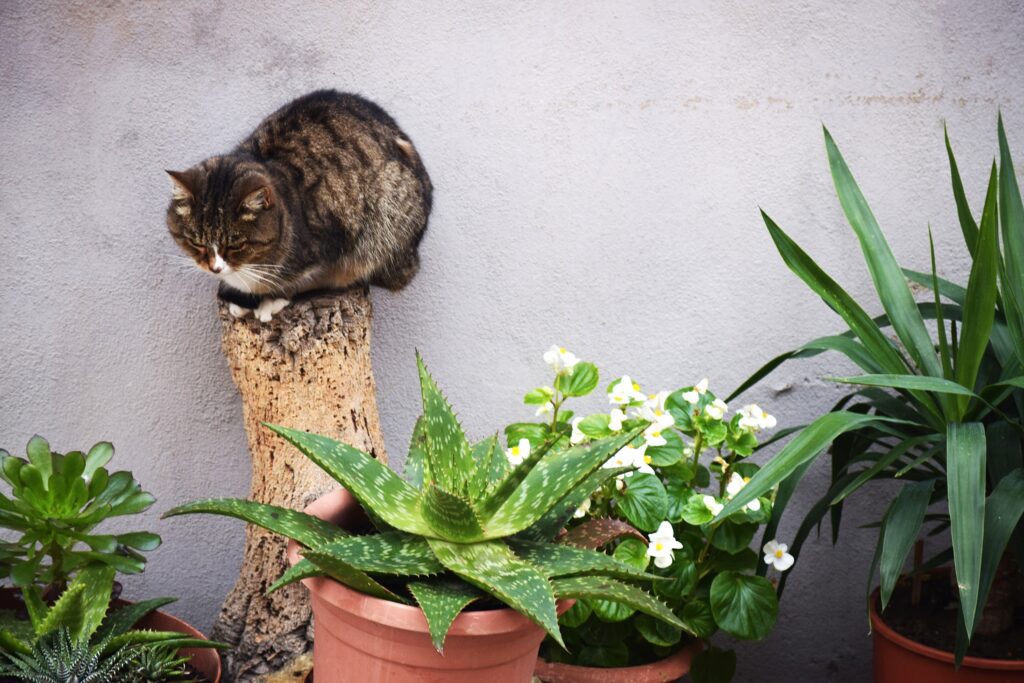Shipping all over European Union ![]() from Romania
from Romania ![]()
- July 21, 2023
Are Aloe Plants Toxic to Cats? Exploring Aloe Vera and Cat Safety
-
by Oana
Contents Summary
Introduction
Aloe plants, with their succulent leaves and reputed medicinal properties, have become a popular addition in many households. As a cat owner, you might wonder if Aloe Vera poses a threat to your feline friend.
In this blog post, we explore the potential toxicity of aloe plants to cats, specific risks they may pose, and most importantly, essential precautions for your pet’s safety.
Understanding Aloe Vera and Its Components

Aloe vera is a perennial succulent known for its gel-filled leaves, which contain various compounds with potential health benefits for humans. Specifically, aloe vera concerns cat safety due to two main components:
Gel: The transparent, gooey substance found inside the aloe vera leaves is widely used in skincare and natural remedies for humans.
Latex: A yellowish, bitter liquid located just beneath the leaf’s skin is known as latex or aloe latex.
Are Aloe Plants Toxic to Cats?

Aspca.org confirms that aloe plants, scientifically known as Aloe vera and belonging to the Liliaceae family, are toxic to cats if ingested. The plant contains saponins and anthraquinones, which can be harmful if consumed by pets. Consequently, cats exposed to aloe may have symptoms such as vomiting, lethargy, and diarrhea.
It’s crucial to be vigilant and take measures. Prevent access to aloe to ensure your cat’s well-being. Additionally, if you suspect your cat has ingested aloe or any potentially toxic substance, contact your local veterinarian or the Animal Poison Control Center (APCC) at (888) 426-4435 immediately.
Toxic Effects of Aloe on Cats
When cats ingest aloe gel or latex, it can lead to various adverse reactions. Cats may experience the following common symptoms of aloe toxicity:
Gastrointestinal Distress: Ingesting aloe may cause vomiting, diarrhea, and abdominal pain in cats.
Loss of Appetite: Aloe toxicity can lead to a decreased desire to eat.
Lethargy: Cats may become lethargic or less active than usual.
Changes in Urine Color: Aloe ingestion might result in discoloration of the cat’s urine.
Muscle Tremors: Some cats may experience muscle tremors or shaking.
Depression: Aloe toxicity can lead to behavioral changes, including signs of depression in cats.
Protecting Your Cat from Aloe Toxicity
As a responsible cat owner, take essential precautions to keep your feline friend safe from aloe toxicity:
No Access: Prevent your cat from accessing areas with aloe plants. For instance, place them in locations that are out of reach, such as high shelves or hanging baskets.
Plant Alternatives: Opt for cat-friendly plants. For example, consider cat grass, catnip, spider plants, or non-toxic varieties like Boston fern or African violet.
Know the Signs: Recognize symptoms of aloe toxicity and seek immediate veterinary attention if ingestion is suspected.
Conclusion
While aloe plants offer potential benefits for humans, they pose a risk to our feline companions. As a result, it’s crucial to be aware of the potential dangers of aloe plants and take measures to protect your cat’s health and well-being. By choosing cat-safe plants and keeping aloe out of your cat’s reach, you can create a safe and nurturing environment for your furry friend. If you suspect your cat has ingested aloe or is exhibiting signs of toxicity, seek immediate veterinary attention for proper care and treatment.
Related Posts
Want to keep up with our blog?
Get our most valuable tips right inside your inbox, once per month!
